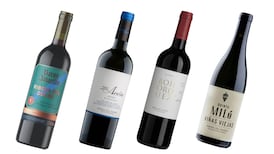T he last thing Englishman Philip Cox wanted on leaving college was a boring desk job, so he headed to Romania, where he ended up, at the tender age of 23, as managing director of the local branch of the massive German wine company, Reh Kendermann.
You may not know the name, but this is the company behind German wines Black Tower and Bend in the River, as well as a large number of own-label brands.
His job was sourcing wine for various Reh Kendermann brands. Cox persuaded the company to make the wine themselves. The next step was buying their own vineyards, but the Germans baulked at this.
Cox departed, and with several partners, including his wife, set up Carmela Recas. The original aim was to buy 50 hectares in Banat (in western Romania), but the government insisted they buy the entire 500 hectare estate and the winery too. Fortunately, they were given five years to pay, effectively bankrolling the fledgling business.
The company has been hugely successful and now has 200 employees, and will sell 12 million bottles of wine next year. It farms 1,000 hectares of vines, and owns a franchise chain of 150 wine shops around Romania.
The vineyards and winery are run on very modern New World lines, with harvesting at night where possible (daytime temperatures can reach 40 degrees Celsius on a regular basis), and a large state-of-art winery.
The company’s Australian winemaker Hartley Smithers spends part of the year working at Cassella – otherwise known as Yellow Tail. The aim is to produce juicy, fruit-filled wines that are sold and drunk within a year.
“Our strategy is to offer a huge range to our customers,” says Cox. “We have over 250 labels and 65 different wines. We listen to our clients and innovate all the time. For 20 years they all wanted international varieties. People don’t buy our wines because they are Romanian. They buy them because they are nice wines with good labels that offer good value.”
In the past two to three years, interest has grown in native Romanian varieties. The international grape varieties include Chardonnay, Sauvignon, Pinot Grigio, Cabernet Sauvignon, Merlot and Pinot Noir, the latter two proving to have real potential.
In Romania, homemade wine accounts for 50 per cent of consumption. Virtually every household has a row or two of vines out the back, and makes their own wine. “Nearly all of it,” says Cox, “tastes like s**t.”
I did visit four other wineries in Romania (I travelled with other Irish and UK journalists, all paid for by Cox), but none are available in Ireland. Halewood is another company founded by an Englishman, and Serve was founded by a Corsican winemaker. Of greater interest were two small wine estates that have been restored to their original owners after the fall of Ceaucesceau.
Princess Illeana Kripp-Continescu and her husband Baron Jakob built a replica of the original winery in Dragasani, in the foothills of the Transylvanian Alps, where her family have owned vineyards for 300 years. She remembers being smuggled out of Romania in an airplane in the early 1960s.
The Prince Stirbey wines, made primarily with indigenous grape varieties, are very good, and available to Irish members of The Wine Society.
Avincus was set up by lawyer Dr Cristiana Stoica, her husband (a professor of law and Minister for Justice for several years) and her family. As with Stirbey, this was a restitution – they rebuilt the ruins of the original home.
Romania appears to have all it takes; a mix of large commercial producers and small estates, as well as its own local interesting grape varieties; aromatic whites such as Feteasca Regala, Feteasca Alba, Tmaîios and Româneasca. Of the red grapes Feteasca Neagra struck me as having real potential. Hopefully we will see more of them in this country in the near future.











